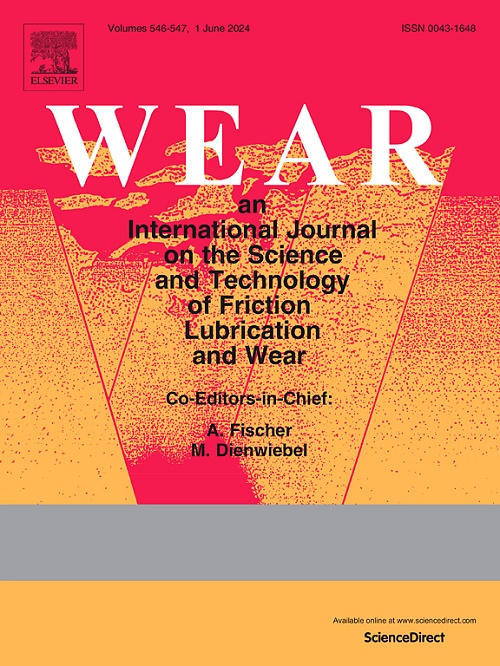Friction reduction and wear resistance properties of electrolytic microtextured surfaces filled with slow-release composite lubricants
IF 5.3
1区 工程技术
Q1 ENGINEERING, MECHANICAL
引用次数: 0
Abstract
The refined design of the surface topography is promising to meet the increasing demands for friction reduction and wear resistance. Based on the electrolytic method and hot-pressing process, three kinds of composite lubricants, MoDTC/graphene, MoDTC/epoxy resin and MoDTC/Al(H2PO4)3, were prepared to fill the microtextured surface to consider the slow-release effect. The high-temperature binding properties of Al(H2PO4)3 allow a slow-release effect of MoDTC/Al(H2PO4)3 composite lubricants, which eventually presents low friction coefficients and wear depths at different temperatures. At 150 °C and 175 °C, the released composite lubricants generate MoS2 in situ to form a protective lubricating film. At 200 °C, the released MoDTC was consumed to generate molybdenum oxide, weakening the friction reduction effect. The synergistic effect of several aspects, including the ability to trap abrasive debris through the dimples, the tribofilm formed by zinc dialkyldithiophosphate (ZDDP) and the protective power generated by composite lubricants, provides long-lasting low friction and low wear control.
缓释复合润滑剂电解微织构表面的减摩和耐磨性
表面形貌的精细设计有望满足日益增长的减少摩擦和耐磨性的要求。基于电解法和热压工艺,制备了MoDTC/石墨烯、MoDTC/环氧树脂和MoDTC/Al(H2PO4)3 3种复合润滑剂填充微纹理表面,考虑缓释效果。Al(H2PO4)3的高温结合特性使得MoDTC/Al(H2PO4)3复合润滑剂具有缓释效应,最终在不同温度下呈现出较低的摩擦系数和磨损深度。在150°C和175°C时,释放的复合润滑剂在原位生成二硫化钼,形成保护性润滑膜。在200℃时,释放的MoDTC被消耗生成氧化钼,降低了摩擦的效果。二烷基二硫代磷酸锌(ZDDP)形成的摩擦膜和复合润滑剂产生的保护力等几个方面的协同作用,提供了持久的低摩擦和低磨损控制。
本文章由计算机程序翻译,如有差异,请以英文原文为准。
求助全文
约1分钟内获得全文
求助全文
来源期刊

Wear
工程技术-材料科学:综合
CiteScore
8.80
自引率
8.00%
发文量
280
审稿时长
47 days
期刊介绍:
Wear journal is dedicated to the advancement of basic and applied knowledge concerning the nature of wear of materials. Broadly, topics of interest range from development of fundamental understanding of the mechanisms of wear to innovative solutions to practical engineering problems. Authors of experimental studies are expected to comment on the repeatability of the data, and whenever possible, conduct multiple measurements under similar testing conditions. Further, Wear embraces the highest standards of professional ethics, and the detection of matching content, either in written or graphical form, from other publications by the current authors or by others, may result in rejection.
 求助内容:
求助内容: 应助结果提醒方式:
应助结果提醒方式:


